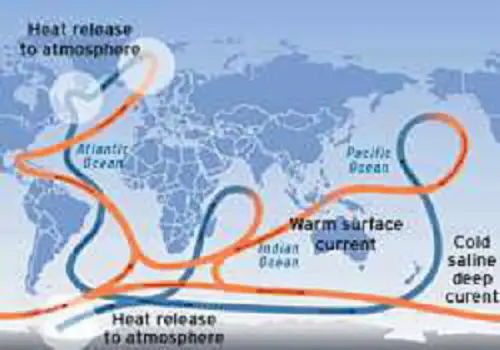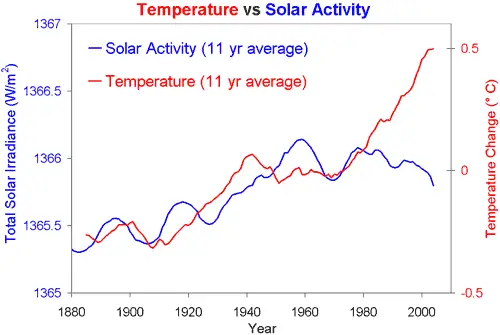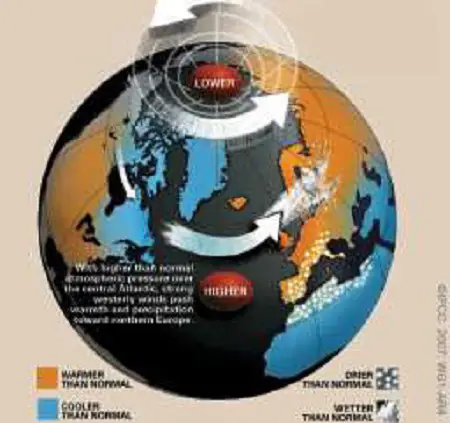Translate this page to any language by choosing a language in the box below.
When most people hear the phrase climate change, they immediately think "atmospheric carbon". But this is a gross over-simplification of the factors that result in the temperature on earth's surface There are many other factors also at work, and in complex ways. Current models to predict climate changes have been demonstrated to be consistent only in their unreliability. In the 70's a global ice age was predicted, then "global warming" and now, to avoid facing the unpredictability of their models, many of these same scientists now simply call it "climate change". And scientists do not agree on what the primary drivers of climate change area. There are many competing theories. See this page about the scientific debate.
But the climate has always been changing, long before humanity even existed. Here's why: the earth’s climate is affected by and changed through many natural causes like volcanic eruptions, ocean currents, movement of tectonic plates, the Earth’s orbital changes, solar variations and internal variability.
 Earth orbital cycles
- Milankovic' cycles (a.k.a., Milankovitch Cycles)
Earth orbital cycles
- Milankovic' cycles (a.k.a., Milankovitch Cycles)Shifts and wobbles in the Earth’s orbit can trigger changes in climate such as the beginning and end of ice ages. The last ice age ended about 12,000 years ago and the next cooling cycle may begin in about 30,000 years. But orbital changes are so gradual they’re only noticeable over thousands of years; not decades or centuries.
The earth makes one full orbit around the sun each year. It is tilted at an angle of 23.5° to the perpendicular plane of its orbital path. Changes in the tilt of the earth can lead to small but climatically important changes in the strength of the seasons, more tilt means warmer summers and colder winters; less tilt means cooler summers and milder winters.
Slow changes in the Earth’s orbit lead to small but climatically important changes in the strength of the seasons over tens of thousands of years. Climate feedbacks amplify these small changes, thereby producing ice ages.
The Milankovitch cycles include:
- The shape of Earth’s orbit, known as eccentricity;
- The angle Earth’s axis is tilted with respect to Earth’s orbital plane, known as obliquity; and
- The direction Earth’s axis of rotation is pointed, known as precession
And here's a deeper explanation of each of these: 

The primary effect volcanoes have on the climate is short-term cooling. Volcanic eruptions pump out clouds of dust, gases and ash, which block out some sunlight.
Because the ash particles are relatively heavy, they fall to the ground within about three months, so their cooling effect is very short-lived. During that period, however, they can block out solar radiation causing a year without a summer, as occurred in 1816. On April 5, 1815 Indonesia’s Mount Tambora rumbled to life. The volcano exploded; the largest volcanic explosion in recorded history. The sky darkened and the Sun was blocked from view. The larger partials fell back to earth, collapsing homes in the area, and floating in the ocean, so thick, ships had to plow their way through it.
But the smaller particles were light enough to reach the stratosphere and spread across the globe. This had a dramatic impact on global climate. Earth’s average global temperature dropped 3 C (5 F). The following summer of 1816 saw the coldest summer temperatures in Europe between the years of 1766–2000. Crops were destroyed by frost or a lack of sunshine in both Europe and North America. This caused a food shortage.
Every schoolchild has heard of the giant eruption of the island of Krakatau in Indonesia in 1883, which certainly is another example. From qz.com
The official death toll recorded by Dutch authorities was 36,417, though some modern estimates put it at three or four times the total. There was a lasting effect on the world’s climate, too: aerosols emitted into the atmosphere by the blast led global air temperatures to drop by as much as 2.2 degrees Fahrenheit (1.2 degrees Celsius). According to a 2006 article in the journal Nature, the volcano caused oceans to cool for as much as a century, offsetting the effect of human activity on ocean temperatures. If the volcano had not erupted, the authors argue, our sea levels might be much higher than they are today.
Reams of data from these explosions enabled us to come up with the answer: volcanic explosions do cause global cooling. Sometimes. Whether or not a specific eruption leads to cooling depends on its size, location and even chemical composition. But Tambora probably did cause the Year Without a Summer.
Volcanic emissions also includes gases, like sulfur dioxide. SO2 combines with water vapor and dust in the atmosphere to form sulfate aerosols, which reflect sunlight away from the Earth’s surface. These aerosols are lighter than ash particles and can remain in the atmosphere for a year or more. Their cooling effect outweighs the warming caused by volcanic greenhouse gases; the eruption of Mount Pinatubo in 1991 caused a 0.5 °C drop in global temperature. The atmospheric SO2 can also produce acid rain, which can result in deforestation, which also then affects weather patterns and atmospheric CO2.
In addition to ash and lave, volcanic eruptions spew out carbon dioxide (CO2). As carbon in natural sources (such as coal and oil deposits) is moved by tectonic plate movement into a volcano or ocean rift, it is again brought to the surface and atmosphere.
And CO2 does have a warming effect. The average volcanic CO2 emissions are generally small compared to CO2 produced by human activity, but there can be exceptions, like a major eruption. In normal times, volcanic CO2 is thought to be less than 1% of emissions from current human activities. .
Large volumes of gases and ash can influence climatic patterns for years by increasing planetary reflectivity causing atmospheric cooling.
Of course, most people recall learning that an asteroid strike is believed by scientists to have caused such profound climate change that it
brought about the end of the dinosaurs. An impact from an object 10km across could:
release huge quantities of vaporized material into the
atmosphere, blocking out the Sun;
See this page for more information.

The oceans are a major component of the climate system. Ocean currents are located at the ocean surface and in deep water below 300 meters (984 feet). They can move water horizontally and vertically and occur on both local and global scales. The ocean has an interconnected current, or circulation, system powered by wind, tides, the Earth’s rotation (Coriolis effect), the sun (solar energy), and water density differences. The topography and shape of ocean basins and nearby landmasses also influence ocean currents.
These currents depend on many factors, including
Deep ocean currents are density-driven and differ from surface currents in scale, speed, and energy.
The colder and saltier the ocean water, the more dense it is. The greater the density differences between different layers in the water column, the greater the mixing and circulation. Density differences in ocean water contribute to a global-scale circulation system, also called the global conveyor belt The global conveyor belt includes both surface and deep ocean currents that circulate the globe in a 1,000-year cycle.
This circulation is the result of two simultaneous processes:
National Geographic says:
The ocean’s global circulation system plays a key role in distributing heat energy, regulating weather and climate, and cycling vital nutrients and gases.
The Sun is the source of energy for the Earth’s climate system. Although the Sun’s energy output appears constant from an everyday point of view, small changes over an extended period of time can lead to climate changes.
Some scientists suspect that a portion of the warm ing in the first
half of the 20th century was due to an increase in the output of solar energy. As the sun is the fundamental source of energy that is
instrumental in our climate system it would be reasonable to assume that changes in the sun's energy output would cause the climate to change.
ing in the first
half of the 20th century was due to an increase in the output of solar energy. As the sun is the fundamental source of energy that is
instrumental in our climate system it would be reasonable to assume that changes in the sun's energy output would cause the climate to change.
Scientific studies demonstrate that solar variations have performed a role in past climate changes. For instance a decrease in solar activity was thought to have triggered the Little Ice Age between approximately 1650 and 1850, when Greenland was largely cut off by ice from 1410 to the 1720s and glaciers advanced in the Alps. Current global warming however cannot be explained by solar variations.
Since 1750, the average amount of energy coming from the Sun either remained constant or increased slightly. If global warming was caused by a more active sun, scientists presently believe this would cause warmer temperatures in all layers of the atmosphere. They have only observed a cooling in the upper atmosphere, a warming at the surface and in the lower parts of the atmosphere.
This is believed to be due to greenhouse gases capturing heat in the lower atmosphere. Also climate models that include solar irradiance changes cannot reproduce last century's observed temperature trend without including a rise in greenhouse gases.
Large scale fires release considerable amounts of carb and particulates while simultaneously removing living plants that remove carbon and produce oxygen; a double whammy for the earth's carbon cycle.
Some changes in climate have no external trigger. These changes are
instead caused by interactions within the climate system itself, often involv ing positive feedbacks.
ing positive feedbacks.
One example is the El Niño–La Niña cycle, which can cause temporary warming and cooling. Both phenomena affect atmospheric circulation patterns and influence global climate. While El Niño increases global temperature, La Niña decreases it. This cycle repeats itself on a timescale of about five years. But these changes are short-term, only lasting a few years.
Another example of internal variability is the Arctic oscillation (AO), which is associated with changing patterns of air pressure in the northern hemisphere.
This phenomenon brings warmer weather to parts of Europe and
North America, leaving the Arctic colder than usual. The other phase of the AO brings the opposite conditions, resulting in a
warmer-than-usual Arctic and colder weather in the sub-polar regions. Because of this seesaw effect, the AO has little effect on global
temperatures, but can significantly
 influence local and regional weather.
influence local and regional weather.
Many natural factors affect the climate, including changes in the Sun’s output or the Earth’s orbit, large volcanic eruptions and internal variability such as El Niño. Scientists measure these effects, but none can account for the observed trend since 1970.
Methane is produce by animals (such as burping bovine), decay of plant matter in forests, swamps and other natural sources. CO2 gets all the attention lately, but methane also impacts how the earth absorbs and reflects solar radiation. Methane is considered to be 100 times worse than carbon dioxide due to it's effect on greenhouse warming.
According to NASA, about 30% of methane emissions are produced by wetlands, including ponds, lakes, and rivers. Another 20% is produced by agriculture, due to a combination of livestock, waste management and rice cultivation. Activities related to oil, gas, and coal extraction release an additional 30%. The remainder of methane emissions come from minor sources such as wildfire, biomass burning, permafrost, termites, dams, and the ocean.

Every 5th grader knows the oceans cover 71% of the earth's surface. Water absorbs and releases heat more slowly that land. So, oceans can act as a heat sink, absorbing and releasing heat from solar radiation.
The oceans are also a carbon sink; absorbing and trapping atmosphere carbon.
Plant and animal life in the oceans affects the carbon cycle, which then impacts temperatures.
The earth's magnetic poles reverse polarity. The north pole becomes the south pole and vice versa. Earth's magnetic pole reversals have happened throughout Earth's history. The last one occurred 780,000 years ago. At present, most scientists say they do not think a reversal of magnetic poles would have a large impact upon life on earth. But no one was there to see when it happened in the past, and the technologies, satellites, power grids, cell phones and computers did not exist during the last reversal, so it's really anyone's guess at this point.
See this page for more information about the reverse of earth's geomagnetic poles.
Many references are included by embedded links to the sources in the text above. Below are others:
Ways to save money AND help the environment:
Eat healthier AND save money: Instant Pot Duo Crisp 11-in-1 Air Fryer and Electric Pressure Cooker Combo with Multicooker Lids that Fries, Steams, Slow Cooks, Sautés, Dehydrates
Save water AND money with this showerhead adapter, it lets the water flow until the water is hot, then shuts off water flow until you restart it, ShowerStart TSV Hot Water Standby Adapter
Protect your health with these:
Mattress Dust mite-Bedbug protector, 100% Waterproof, Hypoallergenic, Zippered
Handheld Allergen Vacuum Cleaner with UV Sanitizing and Heating for Allergies and Pet, Kills Mite, Virus, Molds, True HEPA with Powerful Suction removes Hair, Dander, Pollen, Dust,
Immune Support Supplement with Quercetin, Vitamin C, Zinc, Vitamin D3
GermGuardian Air Purifier with UV-C Light and HEPA 13 Filter, Removes 99.97% of Pollutants
5 Stage Air Purifier, Features Ultraviolet Light (UVC), H13 True Hepa, Carbon, PCO, Smart Wifi, Auto Mode, Quiet, Removes 99.97% of Particles, Smoke, Mold, Pet Dander, Dust, Odors
Interesting Reads:
THE PREPPER'S CANNING & PRESERVING BIBLE: [13 in 1] Your Path to Food Self-Sufficiency. Canning, Dehydrating, Fermenting, Pickling & More, Plus The Food Preservation Calendar for a Sustainable Pantry
The Backyard Homestead: Produce all the food you need on just a quarter acre! Paperback
The Citizens' Guide to Geologic Hazards: A Guide to Understanding Geologic Hazards Including Asbestos, Radon, Swelling Soils, Earthquakes, Volcanoes
The Uninhabitable Earth: Life After Warming
Book: The Sixth Extinction: An Unnatural History Paperback